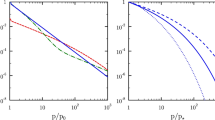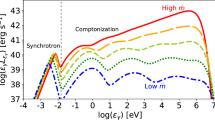Abstract
Recent results of the gamma-ray Cherenkov astronomy definitely prove the existence of fast variability in the very high energy (V.H.E.) gamma-ray flux of some active galactic nuclei. The BL Lac PKS 2155-304 for instance showed variations down to a few minutes time scale. From standard light travel time argument, these variations put extremely strong constraints on the size of the TeV emitting zone, which has to be of the order of a few Schwarzschild radius, even for high values of the relativistic Doppler factor of the emitting jets. Such discovery is a challenge for particle acceleration scenarios, which have to imagine efficient acceleration processes at work in a very compact zone. Eventually, the immediate vicinity of the central black hole appears as the most conservative choice for the location of the TeV emission region of active galactic nuclei. In this paper, we propose a two-step mechanism for charged particle acceleration in the magnetosphere of a massive black hole surrounded by an accretion disk. Particles first gain energy by a stochastic process during the accretion phase. It is shown that effective proton acceleration up to energies 1017–1019 eV is possible in a low-luminosity magnetized accretion disk with 2D turbulent motion. The distribution function of energetic protons over energies is a power law function with typical index ≃−1. Here electrons are not very efficiently accelerated because of their drastic losses by synchrotron radiation. In a second time, part of the fast particles escape from the disk and are then entrained by the magnetic structure above the disk, in the rotating black hole magnetosphere. They thus gain additional energy by direct centrifugal mechanism, up to about 1020 eV for the protons and to 10–100 TeV for the electrons when they cross the light cylinder surface. Such energetic particles can further radiate in the TeV spectral range observed by Cherenkov experiments as HESS, MAGIC and VERITAS. Energetic protons can produce γ-radiation in the energy band 1 GeV–100 TeV and above mainly by nuclei collisions with the disk matter, clouds, or ambient low energy photons. Energetic electrons can also reach the required spectral range by inverse Compton emission. However their acceleration is less efficient due to heavy radiation losses, and only gained by centrifugal process during the second phase of the whole mechanism we describe. Our present analysis would therefore favor hadronic scenarios for TeV emission of active galactic nuclei. It is tempting to relate long term variability over years of TeV active galactic nuclei to the first stochastic acceleration phase, which also provides the needed power law particle distributions, while short term variability over minutes is more likely due to perturbations of the second fast direct acceleration phase.
Similar content being viewed by others
References
Abraham, J., , (AUGER collaboration): Astropart. Phys. 29, 188 (2008)
Acciari, V.A., , (VERITAS collaboration): Astrophys. J. 679, 397 (2008)
Aharonian, F., , (HESS collaboration): Astron. Astrophys. 442, 895 (2005)
Aharonian, F., , (HESS collaboration): Science 314, 1424 (2006)
Aharonian, F., , (HESS collaboration): Astrophys. J. Lett. 664, L71 (2007)
Albert, J., , (MAGIC collaboration): Astrophys. J. 669, 862 (2007)
Albert, J., , (MAGIC collaboration): Astrophys. J. 685, L23 (2008)
Atoyan, A.M., Nahapetian, A.: Astron. Astrophys. 219, 53 (1989)
Becker, P.A., Kafatos, M., Maisack, M.: Astrophys. J. Suppl. Ser. 90, 949 (1994)
Beskin, V.S., Istomin, Y.N., Pariev, V.I.: Sov. Astron. 36, 642 (1992)
Birk, G.T., Lesch, H., Schopper, R., Wiechen, H.: Astropart. Phys. 11, 63 (1999)
Blandford, R.D., Znajek, R.I.: Mon. Not. R. Astron. Soc. 179, 423 (1977)
Boldt, E., Ghosh, P.: Mon. Not. R. Astron. Soc. 307, 491 (1999)
Boldt, E., Loewenstein, M.: Mon. Not. R. Astron. Soc. 316, L29 (2000)
Dermer, C.D., Miller, J.A., Li, H.: Astrophys. J. 456, 106 (1996)
Djannati-Atai, A., Piron, F., Barrau, A., : Astron. Astrophys. 350, 17 (1999)
Foschini, L., Ghisellini, G., Tavecchio, F., : Astrophys. J. 657, L81 (2007)
Gangadhara, R.T., Lesch, H.: Astron. Astrophys. 323, L45 (1997)
Ghisellini, G., Celotti, A., Fossati, G., Maraschi, L., Comastri, A.: Mon. Not. R. Astron. Soc. 301, 451 (1998)
Hillas, A.M.: Annu. Rev. Astron. Astrophys. Camb. 22, 425 (1984)
Istomin, Y.N.: J. Exp. Theor. Phys. 100, 539 (2005)
Katz, J.I.: Astrophys. J. 367, 407 (1991)
King, A.R., Pringle, J.E.: Mon. Not. R. Astron. Soc. 373, L90 (2006)
Koide, S., Kudoh, T., Shibata, K.: Phys. Rev. D 74, 044005 (2006)
Komissarov, S.S., McKinney, J.C.: Mon. Not. R. Astron. Soc. 377, L49 (2007)
Lake, G., Pudritz, R.E.: In: Kundu, M.R., Holman, G.D. (eds.) IAUS 107: Unstable Current Systems and Plasma Instabilities in Astrophysics, p. 471 (1985)
Landau, L.D., Lifshitz, E.M.: Course of Theoretical Physics. Vol. 8, Electrodynamics of Continuous Media. Oxford (1984)
Levinson, A.: Phys. Rev. L 85, 912 (2000)
Lodato, G., Pringle, J.E.: Mon. Not. R. Astron. Soc. 368, 1196 (2006)
Machabeli, G.Z., Rogava, A.D.: Phys. Rev. A 50, 98 (1994)
Mannheim, K.: Astron. Astrophys. 269, 67 (1993)
Neronov, A., Aharonian, F.: Astrophys. J. 671, 85 (2007)
Osmanov, Z., Rogava, A., Bodo, G.: Astron. Astrophys. 470, 395 (2007)
Punch, M., Akerlof, C.W., Cawley, M.F., : Nature 358, 477 (1992)
Quinn, J., Akerlof, C.W., Biller, S., : Astrophys. J. 456, L83 (1996)
Quinn, J., Bond, I.H., Boyle, P.J., : Astrophys. J. 518, 693 (1999)
Rees, M.: Annu. Rev. Astron. Astrophys. Camb. 22, 471 (1984)
Reynolds, C.S., Fabian, A.C., Celotti, C., Rees, M.J.: Mon. Not. R. Astron. Soc. 283, 873 (1996)
Rieger, F.M., Mannheim, K.: Astron. Astrophys. 353, 473 (2000)
Rieger, F.M., Aharonian, F.: Astron. Astrophys. 479, L5 (2008)
Robson: Active Galactic Nuclei. Wiley, Praxis, New York (1996)
Stone, J.M., Norman, M.L.: Astrophys. J. 433, 746 (1994)
Thorne, K.S., Price, R.H., MacDonald, D.A.: Black Holes: the Membrane Paradigm. Yale University Press, New Haven (1986)
Torres, D., Boldt, E., Hamilton, T., Loewenstein, M.: Phys. Rev. D 66, 023001 (2002)
Weekes, T.: Very High Energy Gamma-Ray Astronomy. Institute of Physics Publishing (2003)
Author information
Authors and Affiliations
Corresponding author
Rights and permissions
About this article
Cite this article
Istomin, Y.N., Sol, H. Acceleration of particles in the vicinity of a massive black hole. Astrophys Space Sci 321, 57–67 (2009). https://doi.org/10.1007/s10509-009-0008-8
Received:
Accepted:
Published:
Issue Date:
DOI: https://doi.org/10.1007/s10509-009-0008-8




